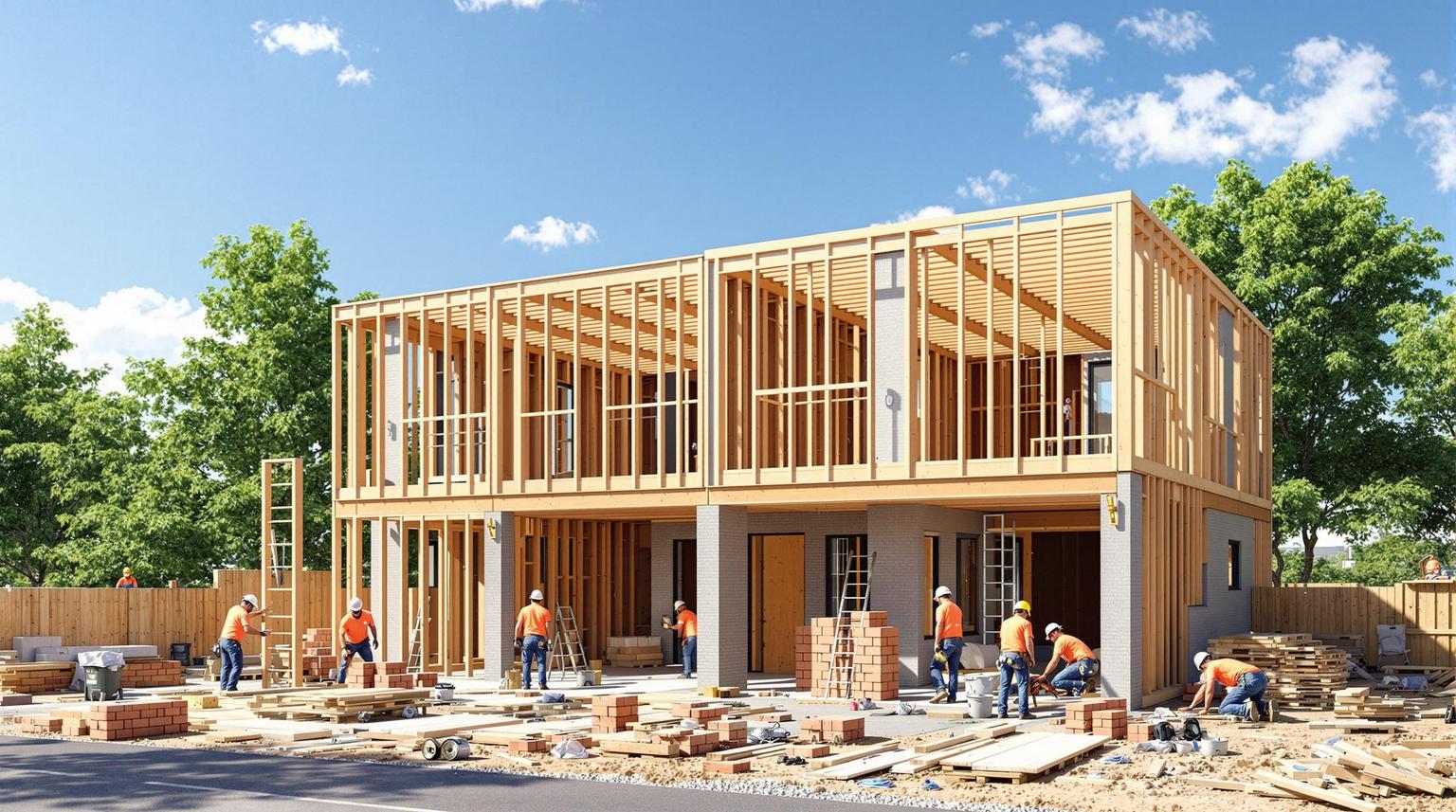Building a house in Nova Scotia typically takes 9 to 12 months, depending on factors like weather, permits, and design complexity. Here's a quick breakdown of the timeline:
- Planning & Design: 2–4 months (permits and custom designs take time).
- Site Prep & Foundation: 4–6 weeks (best done May–October).
- Framing: 4–8 weeks (weather-sensitive stage).
- Systems & Exterior Work: 6–10 weeks (includes electrical, plumbing, HVAC, and weatherproofing).
- Interior Work: 11–17 weeks (insulation, drywall, finishes).
- Final Approvals: 2–4 weeks (occupancy permit and inspections).
Key Tip: Start construction in spring (April–May) to avoid delays caused by Nova Scotia's winter weather. Plan ahead for permits and material orders to stay on track.
| Phase | Duration | Best Timing |
|---|---|---|
| Planning & Design | 2–4 months | Year-round |
| Site Prep & Foundation | 4–6 weeks | May–October |
| Framing | 4–8 weeks | May–October |
| Systems & Exterior Work | 6–10 weeks | Milder months preferred |
| Interior Work | 11–17 weeks | Year-round |
| Final Approvals | 2–4 weeks | Year-round |
Planning and Site Prep
Design and Permits (2-4 Months)
Getting the design and permits right is a critical first step for any build in Nova Scotia. This process usually takes about 2 to 4 months, depending on the complexity of the project and local regulations.
Here’s how the design phase typically breaks down:
- Custom home designs: 4-6 weeks
- Modifications to pre-designed plans: 2-3 weeks
- Engineering reviews: 1-2 weeks
Permit approval times vary by municipality:
| Municipality | Typical Processing Time |
|---|---|
| Halifax Regional Municipality | 8-12 weeks |
| Cape Breton Regional Municipality | 6-8 weeks |
| Rural Nova Scotia | 4-6 weeks |
Important note: If your site is in an environmentally sensitive area, expect additional time for the permitting process.
Once permits are secured, attention shifts to preparing the site for construction.
Site Preparation Steps
Site preparation is a crucial stage that usually takes 2 to 3 weeks. It involves several key tasks, each contributing to a smooth start for the foundation work:
- Property survey and layout: 2-3 days
- Tree clearing and grading: 3-5 days
- Utility connections: 5-7 days
- Access road construction: 2-4 days
Weather considerations:
Nova Scotia’s coastal climate plays a big role in site preparation. Aim to schedule this work between May and October, as wet conditions can delay excavation by 1 to 2 weeks. If you’re working during winter, frost can require specialized equipment, potentially adding time and costs.
For the best results, plan major excavation during dry and stable ground conditions to avoid unnecessary delays.
Foundation Work
Foundation Options (3–6 Weeks)
Building a foundation in Nova Scotia typically takes between 3 to 6 weeks, depending on the type of foundation and the weather conditions. This phase involves several key steps: excavation, forming, pouring, and allowing the concrete to cure.
Here’s a breakdown of foundation types, their estimated timelines, and the best seasons to build:
| Foundation Type | Build Time | Best Weather Window |
|---|---|---|
| Full Basement | 4–6 weeks | May to November |
| Crawl Space | 3–4 weeks | May to November |
| Slab-on-Grade | 2–3 weeks | June to October |
| ICF (Insulated Concrete Forms) | 3–4 weeks | Year-round |
If you’re planning construction during the colder months (December to March), be prepared for added challenges. Concrete curing in low temperatures often requires heated enclosures or chemical additives, which can increase both the timeline and costs. To avoid these complications, aim to schedule foundation work between May and November when conditions are more favourable.
Once the foundation is complete, the next step is ensuring it meets all necessary standards through inspections.
Required Inspections
After the foundation is built, inspections are crucial to confirm it meets Nova Scotia's building codes and structural requirements. Several inspections are required during this phase:
- Pre-pour inspection: Conducted after the forms are set up but before the concrete is poured.
- Post-pour inspection: Takes place once the concrete has cured but before backfilling.
- Waterproofing inspection: Ensures proper waterproofing before backfilling begins.
- Final grade inspection: Assesses the site grading after backfilling to ensure proper drainage.
It’s essential to schedule these inspections ahead of time. If an inspection is not passed, corrections will need to be made quickly, followed by a re-inspection.
A well-constructed and thoroughly inspected foundation is crucial for the long-term stability and safety of your home.
House Frame Construction
Frame Building (4–8 Weeks)
After the foundation is inspected and ready, the framing process begins, transforming the foundation into the skeleton of your home. In Nova Scotia, this phase usually takes 4 to 8 weeks, depending on the size and complexity of the design. During this stage, builders install the floor system, erect both exterior and interior walls, and construct the roof. For a typical 2,000‑sq‑ft home, framing takes around 6 weeks, assuming the weather cooperates. Larger homes or intricate designs may naturally take more time. This step is crucial, as it lays the groundwork for installing systems and completing interior work later on.
Weather Delays
Nova Scotia's climate can pose challenges during framing. Light rain might only cause minor slowdowns, but heavy rain or snow can bring work to a standstill. Cold weather can also impact material quality and require additional precautions to protect supplies and ensure proper curing. Many builders aim to schedule framing during milder months, often using protective coverings to keep the project on track despite unpredictable weather.
Systems and Exterior Work
System Installation (6–10 Weeks)
Once the frame is up and the structure is weatherproof, it's time to install the home’s systems. In Nova Scotia, this phase includes rough-in work for electrical, plumbing, and HVAC systems, which typically takes about 6–10 weeks. For example, electrical rough-ins can take around two weeks, with plumbing and HVAC following similar timelines. Each system must pass inspections by local authorities before moving on to interior finishes. These inspections ensure everything is safe and up to code, setting the stage for the final touches inside and out.
Weather Protection
During this phase, crews focus on exterior finishing and weatherproofing. Tasks like installing the roof, windows, doors, and siding are critical to protecting the structure from the elements. To avoid delays, these jobs are usually scheduled during milder weather. However, Nova Scotia’s autumn and winter months can bring challenges like high winds, heavy rain, or freezing temperatures, which may slow progress. That’s why spring and summer are often the preferred seasons for this stage of construction.
Interior Completion
Walls and Insulation (3–5 Weeks)
Once the systems have passed inspection, it’s time to insulate and finish the walls. In Nova Scotia, where winters can be harsh, proper insulation is crucial for keeping energy costs in check. During this phase, managing indoor humidity is also important since excess moisture can slow down how the drywall compound cures.
Here’s what happens during this stage:
- Insulation: Install insulation that meets building code requirements.
- Drywall: Hang drywall panels securely.
- Finishing: Apply joint compound in thin layers, letting each coat dry properly before sanding for a smooth surface.
When the walls are finished, the focus shifts to adding the interior touches that make the house feel like home.
Interior Finishing (8–12 Weeks)
With the walls prepped, the space begins its transformation into a functional and inviting home. This stage involves several steps, from painting to installing flooring, trim, cabinetry, and fixtures. It’s a collaborative process that requires careful timing and coordination between tradespeople.
To keep everything on track, maintaining the right indoor temperature is key, as it helps materials like paint and adhesives cure properly. Planning ahead is equally important - custom cabinetry, for instance, often comes with long lead times. To avoid delays, it’s a good idea to select and order essential materials, like flooring, fixtures, and cabinets, about 2–3 months before they’re needed.
sbb-itb-16b8a48
Final Steps
Move-in Approval
Before settling into your Nova Scotia home, it’s essential to pass the final inspections and obtain an occupancy permit. These inspections typically cover the building's final state, occupancy standards, and - if your property is in a rural area - well water testing. The approval process usually takes about 2–4 weeks, but any required corrections could stretch this timeline. Once you’ve secured occupancy, your attention can shift to finishing up the necessary outdoor work.
Final Outdoor Work
After receiving your move-in approval, it’s time to tackle the important exterior tasks that ensure your home is safe and functional.
Key Outdoor Tasks Include:
- Ensuring proper lot grading for effective drainage
- Installing a solid base for the driveway
- Setting up basic walkways for safe entry to your home
Seasonal Timing for Outdoor Work:
- April to May: Focus on grading and basic landscaping tasks.
- June to August: Ideal for paving the driveway and building decks.
- September to October: Wrap up any major exterior projects.
- November to March: Limit work to essential maintenance due to weather conditions.
Many homeowners opt to complete only the essential outdoor tasks required for occupancy, leaving more aesthetic upgrades, like detailed landscaping, for the next season when the weather is more cooperative.
The Pros and Cons of Buying New Construction in Halifax, Nova Scotia
Total Timeline Summary
Building a standard 3-bedroom, 2,000 sq. ft. home in Nova Scotia generally takes 9 to 12 months from the initial planning stages to move-in. Here's how the timeline breaks down:
| Construction Phase | Duration | Notes |
|---|---|---|
| Planning & Design | 2–4 months | Administrative phase |
| Site Prep & Foundation | 4–6 weeks | Weather-dependent |
| Framing | 4–8 weeks | Best between May–October |
| Systems & Exterior | 6–10 weeks | Weather-dependent |
| Interior Work | 11–17 weeks | Can proceed year-round |
| Final Approvals | 2–4 weeks | Administrative phase |
Scheduling construction with Nova Scotia's climate in mind is crucial for staying on track. Starting the process in early spring (April–May) helps ensure weather-sensitive tasks, like foundation work and framing, are completed before winter. This approach typically allows for move-in by the following winter or early spring.
Key Timeline Considerations:
- Foundation Work: Requires mild temperatures for proper concrete curing.
- Framing: Heavy rain or snow can slow progress significantly.
- Interior Work: Once the building is enclosed, this phase can continue through winter.
- Permits: Processing times vary, with the Halifax Regional Municipality often taking longer.
- Supply Chain: Delays in material deliveries can impact schedules.
Additionally, unique site conditions, such as rocky terrain or wetlands, can add extra time to the process.
FAQs
What are the main causes of delays when building a house in Nova Scotia, and how can they be avoided?
Delays in home construction across Nova Scotia are often linked to weather challenges and scheduling issues with tradespeople. The province's climate - marked by cold winters and frequent rain - can significantly impact stages like foundation pouring and framing. On top of that, the high demand for skilled trades during peak construction seasons can create scheduling conflicts, making it harder to keep projects moving smoothly.
To minimize setbacks, preparation is key. Start by securing all necessary permits as early as possible and finalizing your design choices before the first shovel hits the ground. Selecting materials and finishes in advance can also help you sidestep potential supply chain hiccups. Partnering with an experienced builder who knows how to navigate Nova Scotia’s climate and juggle tight schedules can make a big difference in keeping your project on track.
How does the type of foundation affect the timeline and cost of building a house in Nova Scotia?
The type of foundation you select plays a big role in shaping both the timeline and cost of building a home in Nova Scotia. Concrete foundations, like poured concrete or insulated concrete forms (ICFs), are popular for their durability. However, they can take longer to cure, especially during the colder months. If you're building in winter, this could slightly delay your project. In contrast, slab-on-grade foundations are faster to install and often more budget-friendly, though they may not be ideal for all sites - particularly those prone to frost heave.
The overall cost depends on factors like materials, labour, and site preparation. For example, a full basement usually costs more than a slab foundation due to the need for excavation and extra materials. To make the best choice for your budget, timeline, and the specific challenges of Nova Scotia's climate, it’s a good idea to consult with your builder.
What challenges does Nova Scotia's climate pose for home construction, and how can they be addressed?
Navigating Nova Scotia's Climate During Home Construction
Building a home in Nova Scotia comes with its own set of challenges, thanks to the province's cold winters and damp conditions. Freezing temperatures can slow down tasks like concrete curing, while wet weather - whether it's rain or snow - can delay exterior work or make framing trickier.
To keep things running smoothly, builders often plan key stages, like laying foundations or framing, during the milder months. If construction continues into winter, extra steps are taken to stay on schedule. For instance, insulated blankets can be used to help concrete cure properly, and proper site drainage ensures water doesn't become an issue. Exterior projects, such as landscaping or driveway paving, are typically held off until spring to achieve better results. With thoughtful planning, construction in Nova Scotia can adapt to the seasonal challenges and stay on track.



